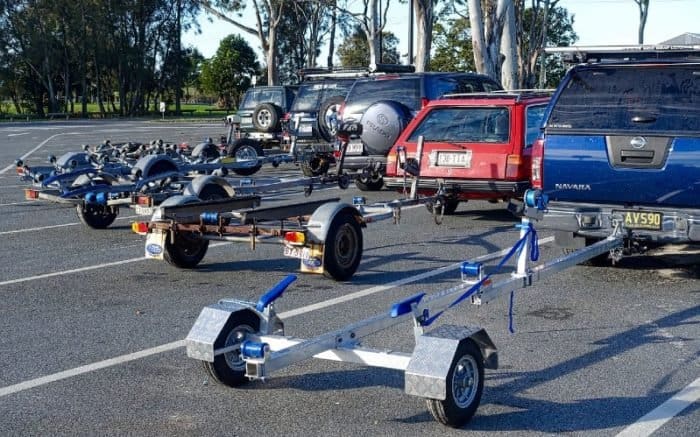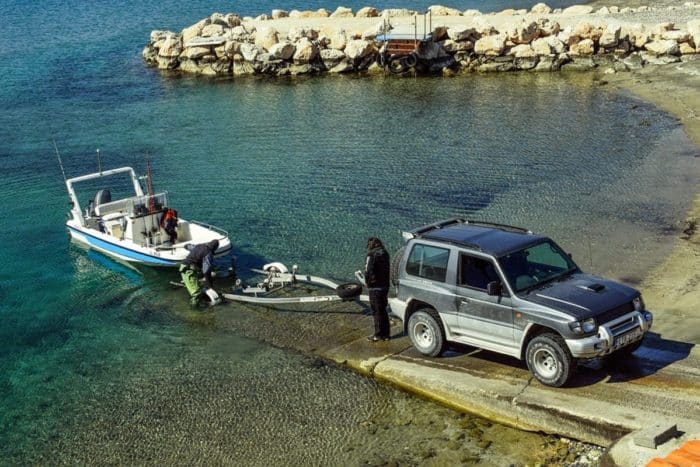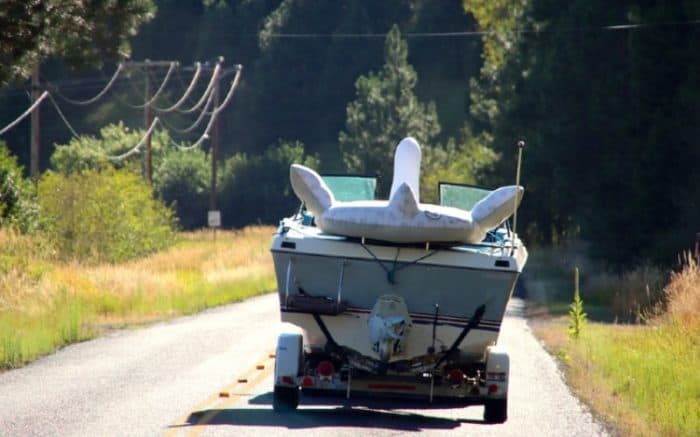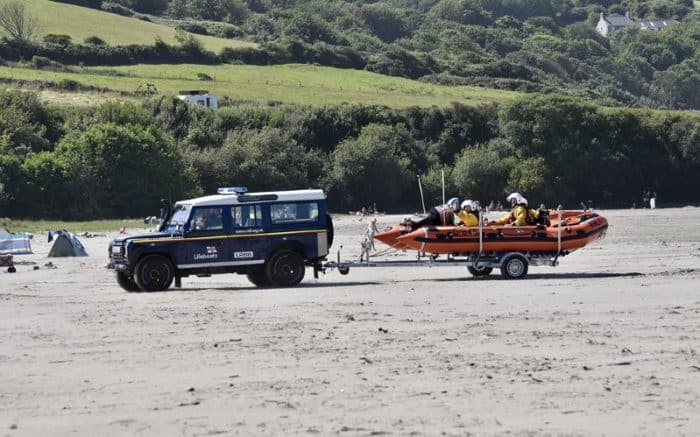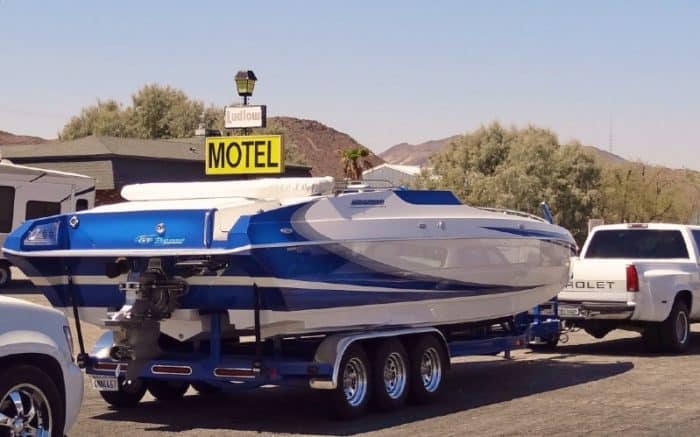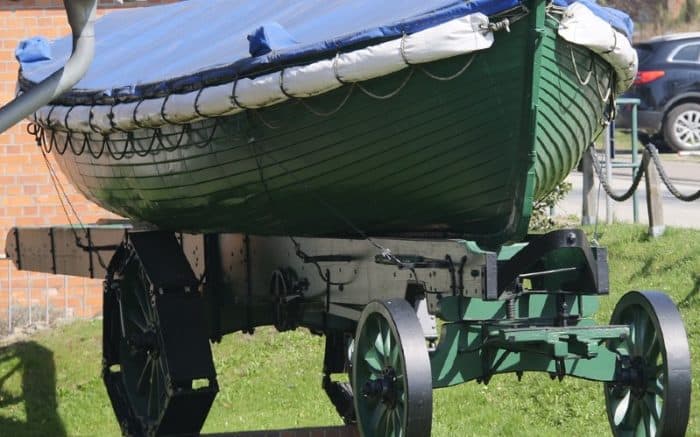How to Drive with a Boat Trailer
Driving for the first time with a boat trailer is not necessarily going to be difficult, but it won’t be easy, either. This is something you will need to practice to master. I strongly recommend practicing in an open space like an empty parking lot until you are comfortable enough with all aspects of driving with a boat trailer before heading out onto the road.
Pre-Drive Check
Obviously, before you go out anywhere, you want to make sure the trailer tires and brakes are in good working order. Check the rollers and bunks before even loading the boat. Check the trailer hitch, the tire pressure, check your brake lights, ensure the boat and trailer are both secure before you worry about the actual process of driving. Make sure you’re not exceeding your towing capacity. Once that’s all taken care of, we can begin.
Reversing While Trailering a Boat
Do not try to reverse your tow vehicle in a perfectly straight line. I would argue that this is likely the most difficult part of driving with a boat trailer to master. It is all but impossible to reverse a trailer down a boat ramp in a perfectly straight line. The best method is to reverse the towing vehicle into a series of micro-corrections that will see the trailer weaving a bit like a fish in the water as you reverse. As long as you take it slow and steady you can keep correcting the trailer as it weaves left and right so that you are still in a mostly straight line as you reverse.
- The first thing you’ll want to practice if this is new to you is reverse turns. As I said, a straight reverse is all but impossible so you’ll be making many tiny left and right turns to weave the boat backwards. For those new to driving with a boat trailer, this is a little daunting at first because you’ll be turning in the opposite direction you want the trailer to go, don’t forget. Turn the wheel right and the trailer will start to swing left. Turn the wheel left and the trailer will correct to the right. If you keep these turns tight at a steady, manageable pace, you can reverse as close to straight as possible.
- Some boaters like to switch this up by holding the steering wheel from the bottom. If you place your hand at the six o’clock position on your steering wheel then it may seem a little more intuitive for you as when you move your hand right, the boat turns right and when you move left, the boat turns left. Try this method and the other method to see which feels more comfortable to you.
- Use side mirrors frequently to get an idea for the trailer’s location relative to the back of the tow vehicle. If you can make use of extended or larger mirrors to get a better angle, do so. If you have a smaller boat, you can use the look over your shoulder method to navigate by looking out the rear windshield and over the boat itself.
- Don’t be afraid to straighten out and try again. If the trailer starts to get away from you, you end up at a bad angle, or anything like that, put the truck in gear, drive forward until you’re straightened out, then get ready for another go.
- I’d recommend practicing this until you’re comfortable enough to reverse the boat trailer cleanly into a parking space or through an obstacle you have set up. In an empty parking lot you can set this up with parking cones or anything else you have that’s easy to see. For boats, life jackets make good obstacles since you probably have a few on board. Set them up like parking cones in the lot and then reverse around one or between several in an effort to keep the trailer straight.
Turning While Driving a Boat Trailer
Another difficult aspect of your drive will be taking turns. You’ll want to stick to the outside lane whenever possible for turning because your turns are going to be wider than you’re used to. The outside turn lane makes this process a little easier, if you have one available.
Corners just can’t be done as sharply because of how a trailer and a tow-rig connect. That means, as you turn, the trailer is going to pull in tighter to that turn. If you take a tight corner, there’s a good chance the trailer will ride up on the curb. Obviously, you want to avoid that as much as possible.
You need to take those turns wide from the outset. Don’t cut the steering wheel at all until the wheels of your tow rig have passed the inside curb.
Passing and Being Passed While Driving a Boat Trailer
If you feel confident that you can manage turns and reversing with a boat trailer, you don’t have much left to do except to get out there and drive. Presumably that’s going to see you taking the trailer and your boat out on the highway with some heavy, fast moving traffic. This is arguably the final, most harrowing part of driving with a boat trailer. It’s not as simple as just driving normally, even when you’re just going in a straight line.
If you’re new to this, you won’t be aware of how not just passing but being passed with a trailer feels. For most vehicles it doesn’t matter but for a passing tractor trailer, you can give yourself a bit of a break when they pass you by easing up on the gas. No doubt you’ve experienced a massive truck passing you on the highway and that gust of wind that you get as it does so. When that happens and you’re towing a trailer, you can literally feel it in your hands as it shakes the vehicle and the wheel in your grip.
When you see a big truck coming up on you in the mirror, let up on the gas just as they begin to pass. That will smooth out the ride a little and prevent the trailer from swaying as badly as it otherwise would. You’ll feel more in control and steadier as a result.
When it comes time to pass another vehicle yourself, remember to allow for more room and more time. It’s going to take you longer to accelerate and you need the added space to get ahead of someone else. Only pass another vehicle when you are sure you have enough space to do so safely. In all honesty, unless the car you’re passing is going unbelievably slow, as in much slower than the actual speed limit, then you’re just as well to maintain course and stay where you are.
Stop The Tow Vehicle for a Mid Trip Check
At some point in your trip you’re going to want to pull over at a rest stop and give your boat trailer a solid once over. This is to ensure continued safety along the journey. It doesn’t need to take long but it’s worth it to do a thorough check. That’s doubly true if you’ve been having any issues.
- Start with your hitch. Make sure the coupler looks good and wires and safety chains are still positioned and connected correctly.
- Check your trailer tires. Look for any wear, make sure they aren’t overheating and nothing looks unusual. Check the lug nuts to make sure they’re still tight and feel around for any heat around the bearings.
- Double check your trailer lights to make sure they’re still working correctly.
- If everything on the trailer looks good, double check the boat now, starting with the engine to make sure it’s still in the right position.
- Check the transom straps and make sure everything is tight and secure.
- Finally, check the boat interior. If you’ve had any issues with fish tailing or swaying, you may want to make sure nothing inside shifted to one side or the other, and that anything heavy is properly secured so it can’t move around.
Other Tips for Driving with Boat Trailers
All of this will become second nature in time, but your first time out it can be a little daunting to figure everything out. With that in mind, here are a few other boat trailer tips that will ensure the best driving experience you can have.
- Practice stopping early. You want to give yourself more time for a stop when towing a boat than you normally might. This is true even if you have a top of the line trailer with great surge or electric brakes. It’s from an overabundance of caution that you never want to push the brakes too much. The physics of towing a trailer means that braking will take a little more time and room than braking without a trailer.
- Give room to accelerate. Like stopping, accelerating takes more time with a trailer. You need more space when you’re merging or when you’re passing other vehicles.
- Watch for Swaying. If your trailer is swaying while you drive you need to stop and adjust how your trailer is attached at the tongue. The load percentage is probably off and your weight distribution is causing the problem. The tongue weight of a trailer is supposed to be 10 to 15% of the entire trailer weight.
- Shift down hills. In most vehicles when you go down hill you will hit the brakes to slow your momentum on a downslope. You can do this when towing a trailer as well, but it’s a good idea to also downshift when you’re heading down a hill. Slipping into a lower gear lts your engine better control the speed when you’re carrying a heavy load like a boat trailer. If that’s not an option, just remember to give yourself time to both slow down and then accelerate again at the bottom. You don’t want to hit the brakes hard and risk an accident.
- Avoid serious wind. If you’re a seasoned driver when it comes to towing a boat trailer this may not apply. But if you’re new, and the wind is bad enough, you may want to find shelter to ride out the storm. Much the same as the pressure around a passing rig can cause your trailer to sway, a stormy day with high winds can make you endure that non-stop. It can be hard to control a bigger boat and trailer in conditions like these and if it’s your first time trying, it may be more than you can handle. You may want to head to the nearest rest stop or some place where you can pull over and wait it out until conditions are a little more stable.
- Ease out of a fishtail. When you lose control of a boat trailer, which can happen due to a fierce gust of wind, a sudden adjustment at the wheel, or even a shift in load weight, the boat trailer may begin to fishtail. The trailer will sway back and forth behind the tow vehicle and it can be extremely stressful not to mention potentially dangerous. You need to remain calm if this happens and, rather than overreact, take it very easy to ride it out. Slow your vehicle down gently and remain on a steady course. Don’t try to steer sharply out of a fishtail because the trailer is already wobbling. If you try to steer sharply out of it, you’ll make it worse. A gradual slowing on a straight and narrow course should bring the trailer back in line. The fishtail will begin to lessen until it’s no longer weaving at all. Once you’ve eased out of it, pull over when you can to see if you can determine why it happened in the first place.
- Check your hubs when you stop. Any time you stop either to gas up, get food, or when you reach your destination, take a few seconds to go touch the hubs of your trailer wheels. If you feel heat then you have an issue with your bearings. This could cause serious damage to your trailer later on and it’s a real safety issue, so keep an eye out.
The Bottom Line
Driving with a boat trailer takes a little more caution and skill than driving without one. Once you have had practice it’s not difficult at all, but when you’re new it does take getting used to. Make sure you practice reversing and turning especially, as they can be the trickiest parts. Get a feel for how long it takes to both accelerate and brake safely. Be prepared for dealing with gusts of wind and fishtailing, and make sure you do a safety check part of the way through your journey. As always, stay safe and have fun.
Categories: Boats
